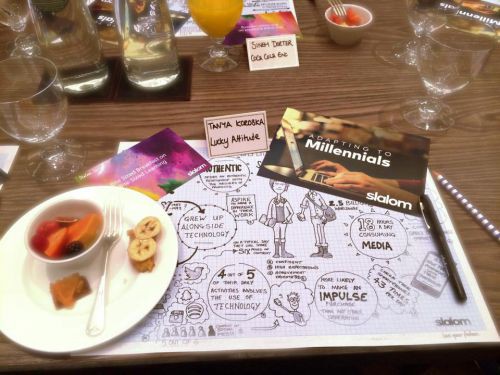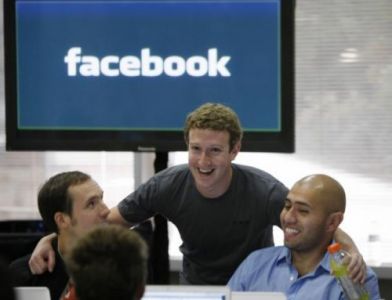Adapting To Millennials: Discussion By Slalom

Slalom is an American business and technology consulting firm that helps some of the world’s biggest companies to solve their most complex and interesting business challenges.
Slalom recently opened their offices in London and kicked off their London launch with a series of discussions about Millennials, technology and innovation.
From customer engagement to employee retention – Millennials are at the forefront of everything Slalom does.
In March 2015, I was invited to their first discussion ” Adapting to Millennials ” alongside brands like Coca-Cola, eBay, Google, John Lewis, Vodafone, Louis Vuitton and Expedia.
What did we talk about?
The discussion was focused on customer needs, influence and organizational change.
People first, technology second
Understanding Millennials and how companies need to adapt is not about creating new technology or digital transformation, but is more about getting back to understanding customers and what experiences they expect.
The bottom-up company culture is based on the idea that initiatives for change should come from employees not management. Bottom-up culture doesn’t just apply to white-collar office jobs, but is also relevant to the retail industry as they need to better understand customers in a brick-and-mortar setting. No matter what industry we’re talking about, it’s time for companies to get more personal with their employees and customers.
Ask your your floor-staff or customer service assistants for feedback. They are the real catalyst for change, because they deal with customers directly every day. Involve them in your change processes and you are more likely to make the best decisions.
Millennials drive brand
Branding is not about your vision for the better future, it’s about understanding the passions of your target audience.
Think about which aspects of culture or shared experience could be considered “native” to Millennials that you wouldn’t find in other generational groups.
Two of them are certainly:
1) Connectedness
Millennials are the most connected generation ever, which means that all experiences are instantly shared with their friends and communities.
2) Nonconformity
Millennials don’t conform to the norm and old-fashioned ways of doing things. For example, traditional route of education, career advancement and stability is the norm for some, but many others are redefining success to incorporate more attainable and controllable aspects such as value alignment, creativity, purpose, and fulfillment.
These two identity characteristics – connectedness and nonconformity – create an environment where Millennials are more conscious than ever about which people and companies they align themselves with.
Companies that consider Millennial passions and identity in their branding open themselves to huge opportunities – they turn their customers into genuine brand advocates.
Brand advocacy/ word-of-mouth marketing is the most powerful marketing today. 95 percent of Millennials say that friends are the most credible source of product information and 98 percent of Millennials are more likely to engage with a friend’s post over a brand’s post. In fact – 67 percent of Millennials reported that they have never clicked on a sponsored story – they don’t trust advertising.
As marketers, this means we shouldn’t be thinking of Millennials as just another group of consumers to convert, but as potential advocates for our brands. Advocates not only purchase – they influence their friends to purchase as well.
Here are two ways brands can spark these connections to create consumer relationships with meaning:
1) Brands need to be open, honest and ethical about their products and services. Millennials as well as other consumers of today are incredibly good at identifying lies and external motives.
Millennials want to consume new technologies and content more than any other generation before, but are highly sensitive to people and businesses that are not seeking a win-win situation.
2) Marketing to Millennials should be less about youthful faces and skinny models in advertising and more about identity characteristics (nonconformity, connectedness, tolerance, civic-mindedness, pragmatic idealism)
Work change is hard
The older generation understands and even relates to the Millennial working needs. Who wouldn’t like summer and winter working hours, flexible and transparent work cultures? But taking that leap to change deep-rooted habits, is harder than one might think.
Any kind of change makes people feel out of control – it’s scary, because identity and sense of worth are connected to our current behavior, and change will result in a new (and uncertain) identity or a loss of self-esteem.
It’s very important that everyone in the organization is ready for change. All workers have to be 100% convinced that change is necessary for success. There needs to be a mutual goal or aspiration that is accomplished by the change.
If people are not convinced and somebody decided on their behalf, the result is a feeling of having something done to you. That can leave staff feeling disengaged, misunderstood, and that no-one cares enough to help them through the changes. People need to understand why they should change and what is in it for them before change becomes easy.
Even though, more and more organizations are starting to realize that leadership just can’t dictate change, some members of our discussion agreed that in practice most employees don’t readily take on new behaviors without some help. In other words, cultural change is hard if you don’t have an encouragement from the top.
Change doesn’t take hold because of people – strong leadership or executive sponsorship is frequently cited as the most important factor for a successful initiative.
Initiative, however, should be soft and inclusive. People should believe that the change is the best possible option that benefits not only an organisation but also everyone in it.
So, where to start from?
Everyone reacts to change differently. Using Myers Briggs personality types to understand people’s reaction to change results in 16 different ways to engage and motivate people.
If someone tries to motivate me using a style that is misaligned with my personality type, it’s likely to take me longer to get engaged with the change.
To accomplish that, here are five things you can do:
- Advocate for the change actively within the organization
- Use your authority to provide resources needed for successful change
- Make yourself available to your team for the actions that are uniquely yours
- Build credibility so that your leadership efforts are seen as sincere and believable
- Communicate effectively and continually
Summary
The clash of culture between the fast and agile Millennials and more traditional organisations is challenging. It is, however becoming a tipping point, where organisations just have to adapt, if they want to attract and keep the best talent.
This should be done by devolving decision making, placing trust in the workforce, and embracing the blockers. Its not necessarily a question of structure but more of a cultural change, which takes time.
One approach is to start small, think in bit sized chunks with teams working together with open tools, process and resources – completely focused around the customers, suppliers and employees.




